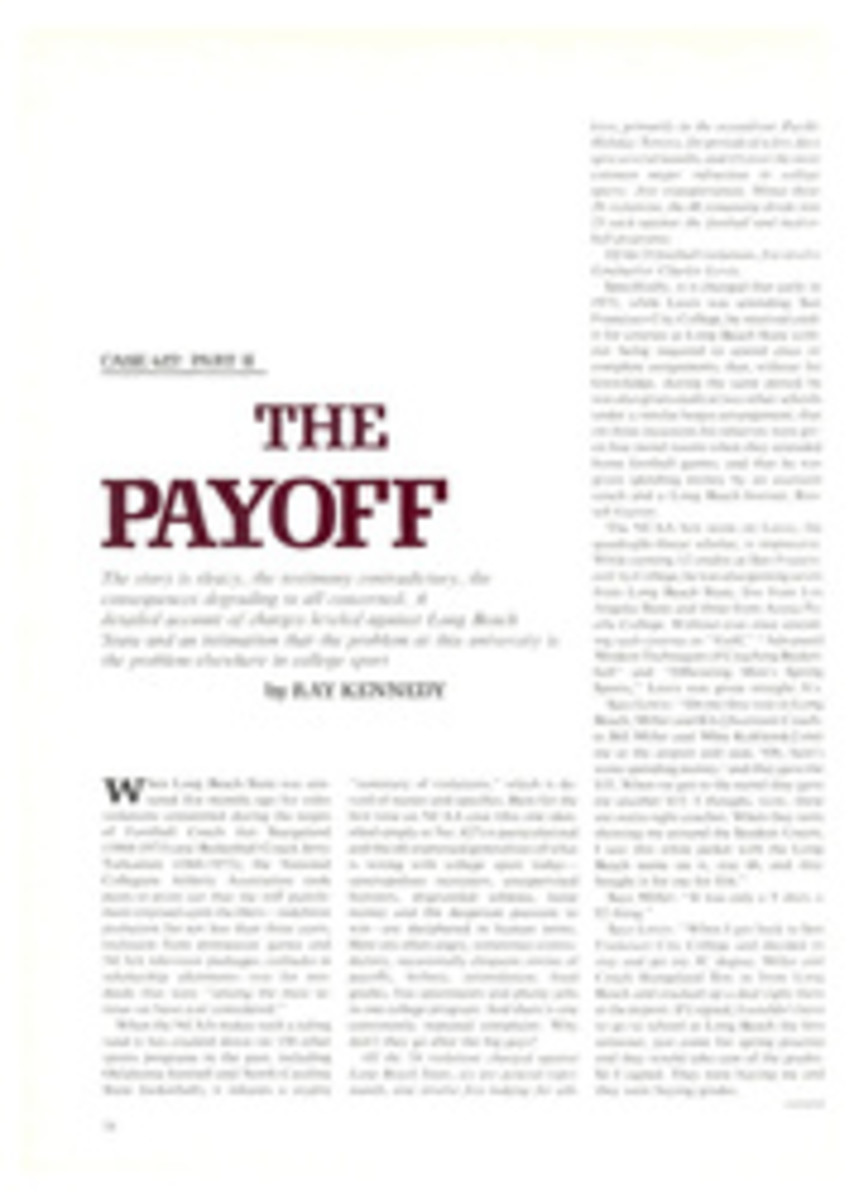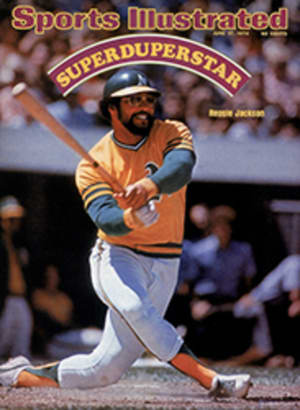
SCORECARD
CHANGE FOR THE GOOD
Modification of the National Football League's new punt rule was almost an inevitability after the coaches tried it out in pre-training camp scrimmages. To encourage more punt returns, NFL owners had approved a change that prohibited any player on the kicking team from running downfield until the ball was kicked, but the coaches discovered that under this restriction no one got within 12 or 13 yards of the returner at the moment he fielded the punt. Punt returners, they claimed, would convert all kicks into touchdowns, or at least long runs, and that would stereotype the game as much as no return at all.
A dubious argument, at best—long punt returns are fun. A more frightening prospect persuaded the owners to allow the wide men on either end of the line to go downfield at the center snap. This more serious threat was that the coaches would instruct their punters to kick out of bounds.
There was another good reason to change the new rule, suggests Dr. Robert Kerlan, the famed orthopedist. More injuries would result.
"The receiving team can rush just enough people to make sure there is a punt," he says. "It can arrange the rest of the players in a picket line so that they will get tremendous blocking angles on the men coming downfield to make the tackle. The fact that they are going to get more time to produce blocks undoubtedly means more injuries in a situation that already has a high injury rate. However, the other new rules, such as the elimination of the crack-back block, should more than offset this increase in injuries."
The change on a change makes sense.
NORTHERN LIGHT
Dolly Connelly, our indefatigable correspondent from Washington state who has strings out to contacts all over the Pacific Northwest, heard from one of them the other day. Grace Slwooko of Saint Lawrence Island, high in the Bering Sea off Alaska, reported: "There is one polar bear killed by one man. Alex Oozeva got one. It is still a great occasion for the time in the life of a man for an event like this, even now we have powerful weapons like guns and ammunition, still the animal is not an anything."
MONSTER OF THE FAIRWAY
If sometime during the U.S. Open at Winged Foot you get the feeling, either live or on TV, that you are witnessing a highly sophisticated operation, like a space shot countdown, you will not be far from wrong. Stationed at all the holes will be men intently studying delicate looking devices covered with numbers swiveling around on base plates attached to tripods. The instruments are range-finders, and when you hear that Johnny Miller made a 16½-foot putt on the 17th green, for once you are going to know that he did just that—made a 16½-foot putt, no more, no less.
This is all part of a fairly massive effort by IBM to bring golf into the 21st century, ahead of time. There will be six rangefinders at various locations on the Mamaroneck, N.Y. course, two more in the clubhouse and three in the press tent, computer operators will be winging questions into computer control center and getting replies instanter on an overhead screen.
Want to know late on Saturday afternoon who has had the highest putting efficiency on first putts? Blip, blip, blip—printout. Who has had the most holes over par? Blip, blip. Toughest hole to keep drives in fairways? Want to compare three golfers in all the important disciplines of the game? You've got it. Oh, yes. You can get the exact standings of the entire field anytime you want them. IBM volunteers in white shirts will be phoning in the golfers' every move from all over the sward.
Outside of how the pros will utilize all this data—only a fool would hazard a guess—there are two distinct problems we can anticipate right off. First, someone is going to have a nervous breakdown trying to think up enough good questions to keep the omnivorous computer fed. Second, and worse, we are all going to have nervous breakdowns if the TV commentators pass on even a fourth of what they learn.
HEADY STUFF
"Now listen," said the coach sternly, "when your model comes back, don't start combing her out right away. Wait till the other models get back. Let's not fiddle around."
The speaker was Sally Hantz of San Mateo, Calif., known to her charges as "dirty Sally" because of her emphasis on rugged training, long practice and curfew. Dirty Sally is coach of the United States Olympic Hairstyling team, which was in Louisville last week for an exhibition before 500 hairdressers and cosmetologists. This September the five-person team will go to Vienna to compete with 30 other nations in the world championships staged every two years by the Confederation International d'Coiffure. According to Coach Hantz, it can out-comb, outcurl and outstyle any U.S. five the country has fielded since first entering the Olympics in 1960. "We've never finished better than fourth," she says, "but this time we're strong in all categories. I think we're really going to show them some good heads."
The Olympics are patterned after the real thing although, heaven help us Mr. John, there is no connection between them. Each stylist competes in four categories—day, evening, mode of the day and gala. The work is judged for appearance. Gold, silver and bronze medals are presented on a victory stand, national anthems are played and flags are waved.
Competition is conducted very much as it was in the Cochran Room of Louisville's Gait House. In the middle was a stage with a pink-and-white-striped curtain background and, poking into the audience, a runway with five dressing tables and chairs. As each Olympian was introduced, he or she walked down the runway to shouts and whistles and took up a position at one of the tables. Then came the models, whose job it is to sit still and smile woodenly while the athletes do their stuff. Standing, bending, leaning over on one foot, the five stylists worked quickly, their fingers nimbly transforming the forests of curlers and bobby pins into styles that one almost never sees except on the pages of women's fashion magazines.
"This team really loves to work," Sally exulted, but then admitted sadly that, good as it was, it probably would not knock the spray cans out of the hands of the Germans, Austrians and French, who dominate the Olympics. This country's one hope, she said, is that the judges will stress the technical aspects of hairdressing, in which the Americans are strongest, rather than the artistic. But the prospects are not good. "The judges are mainly European. We're competing in their backyard, so to speak. I'm sorry to say it, but, yes, I'm afraid politics enters into the judging."
Oh, dear.
THE COVER-UP
The most troubling question raised by the investigation of athletic department practices at Long Beach State (page 24) is a too familiar one. How can honest men attempting to achieve laudable goals—the financial betterment of a university, the reclamation of young athletes from ghetto life—go so wrong?
"I am not a crook," Basketball Coach Jerry Tarkanian all but says in his repeated defenses of his role.
"Everybody does it," protest Long Beach State's former football coaches.
"None of our people had a rigorous education...into no-nos," sums up contrite University President Stephen Horn.
To date nobody has walked into the office of NCAA Director Walter Byers and said, "There is a cancer on your institution." But anytime now, somebody might, because many of the men who run big-time college sport—athletic directors, coaches and, ultimately, university presidents—are harboring serious reservations about things they themselves are doing. Being forced to do, they would say, in order to remain competitive.
Coaches are not hired to lose, and the pursuit of the required victories has led to ever-escalating transgressions of what is legal, as defined by NCAA rules, and what is moral, as defined by anyone. Their tendency concerning such matters as the enrichment of prize recruits by boosters and others is to follow the precept: "Don't tell me what you do. And get it done."
Intercollegiate sport is a wonderful American institution. It has enlivened our weekends and freshened our spirits for more than 100 years. But those who care about it and those responsible for its vigor and its dignity must understand that it is as vulnerable to materialism, pragmatism and amorality as any other aspect of our lives.
COMMEMORATION
Sculptors have devoted themselves to war heroes, the pioneer woman, millionaire patrons and racehorses. But a two-pound salmon?
Ten years ago a silver salmon, nicknamed Indomitable, lived up to that name by defying both probability and modern plumbing. He swam from a stream near Orick, Calif. through a maze of drainage pipes back into the Prairie Creek Fish Hatchery rearing pond where he was born.
The news of that sewerage-defying feat spread, and Floyd Davis, a sculptor from Gasquet, was inspired. He spent over two years making a 21-foot-long redwood likeness of Indomitable. The result, all five tons of it, was unveiled recently at Orick before more than 200 spectators. Seemed a pretty big fish for a little pond.
MONEY SQUEEZE
The long hockey season has just ended, but already Toronto Maple Leaf President Harold Ballard has announced that his sixth-ranked team will command the highest ticket prices in the league when play resumes four months from now. Ballard has painted his prestige seats gold—they were red and $7.70 apiece—and will charge $12 a game for them, or $1,032 a pair for the 40-game season plus three required exhibitions. Despite coloring the best of the reds gold, Ballard will have more reds available. This is because there will be 5,200 fewer blue seats. Reds will be $10 this time around and those blues bad enough to stay that color will go from $6.60 to $8.
Things are somewhat less golden with Toronto's soccer Metros. They won their first three games and expected at least 10,000 last week when they played the Seattle Sounders. Approximately 4,900 showed. Far from raising seat prices, exasperated President Bruce Thomas offered to pay people to attend. The first 1,000 youngsters under 16 to arrive at the next home game will receive a dollar each if they will sit in the end-zone seats and cheer for the Metros. "If we're going to go down, let's not go down in silence," said Thomas.
Apparently painting seats in loud colors helps only if the game is hockey.
CLOCKWORK LEMON
The most novel solution to the growing problem of unruly sports fans (page 10) that we have heard lately is one suggested by Englishman John Harris, secretary of soccer's Tottenham Hotspur Supporters Club. "Issue each fan an identity card. If there were any misconduct the passport would be taken away from him. In this way no hooligan could ever enter a stadium in the country again." Maybe nobody would enter a stadium again.
ILLUSTRATION
THEY SAID IT
•Dick Vermeil, new UCLA football coach, on the Denver Broncos' John Ralston: "You can't insult Coach Ralston. He relishes the challenge of converting a jerk into a friend."
•Mona Schallau of the Minnesota Buckskins, assessing her tennis game: "My volley is blah. I'm a dead elephant on the court. My serve has no sting and I am confused. Other than that I'm a fine player."
•Penny Ann Early, jockey who embarked on a vigorous training program to regain her riding form: "My vital statistics aren't very vital anymore."
•Robin Yount, 18-year-old Milwaukee Brewer shortstop, asked what he thought of the A's Vida Blue after facing him for the first time: "He's good. I used to watch him on TV when I was a kid."

